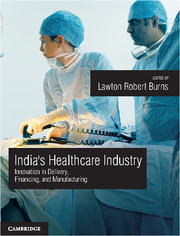Book contents
- Frontmatter
- Contents
- List of Figures
- Preface
- Acknowledgments
- SECTION I Introduction: Lenses and Frameworks for Analyzing India's Healthcare System
- SECTION II Providers: Delivery of Healthcare Services
- 4 The Medical Profession in India
- 5 India's Hospital Sector: The Journey from Public to Private Healthcare Delivery
- 6 Medical Tourism: Opportunities and Challenges
- 7 The Aravind Eye Care System
- 8 The Real Deal at L V Prasad Eye Institute: Excellence and Equity in Healthcare
- 9 Vaatsalya Healthcare: Promoting Access to Healthcare in Rural and Semi-Urban India
- SECTION III Payers: Financing of Healthcare Services
- SECTION IV Producers: Manufacturers of Healthcare Technology
- Contributors
- Index
9 - Vaatsalya Healthcare: Promoting Access to Healthcare in Rural and Semi-Urban India
Published online by Cambridge University Press: 05 June 2014
- Frontmatter
- Contents
- List of Figures
- Preface
- Acknowledgments
- SECTION I Introduction: Lenses and Frameworks for Analyzing India's Healthcare System
- SECTION II Providers: Delivery of Healthcare Services
- 4 The Medical Profession in India
- 5 India's Hospital Sector: The Journey from Public to Private Healthcare Delivery
- 6 Medical Tourism: Opportunities and Challenges
- 7 The Aravind Eye Care System
- 8 The Real Deal at L V Prasad Eye Institute: Excellence and Equity in Healthcare
- 9 Vaatsalya Healthcare: Promoting Access to Healthcare in Rural and Semi-Urban India
- SECTION III Payers: Financing of Healthcare Services
- SECTION IV Producers: Manufacturers of Healthcare Technology
- Contributors
- Index
Summary
Introduction
Vaatsalya Healthcare, a chain of 15 hospitals in the Indian states of Karnataka and Andhra Pradesh, has embarked on a truly unique venture. Their facilities provide the most-needed types of primary and secondary care at affordable prices to populations that otherwise lack access to these services. At first glance, this description seems hardly revolutionary. However, given the scale of the healthcare access and cost obstacles they are tackling, it is remarkable. This chapter presents primary and secondary evidence of the lack of access to affordable basic medical care in rural and semi-urban areas of India. It then examines the business model that has made Vaatsalya successful in addressing this challenge. The chapter examines three defining aspects of their model: first, the guiding principles behind selecting hospital locations and specialties; second, strategies for attracting and retaining qualified clinical staff; and third, strategies to keep costs low. The chapter concludes by discussing two issues: the current challenges that Vaatsalya faces as a result of its rapid growth, and its recent internal quality improvement projects.
Primary evidence on lack of access to low-cost care
The lack of access to affordable care in India, particularly outside of Tier I cities, has been described in several chapters in this volume and in the literature. Access is especially challenging in rural areas: not only are there insufficient numbers of facilities, but even when facilities exist, the necessary specialists are frequently not posted there (see Chapter 3). The impact of this shortage is reflected by many public health indicators but perhaps most clearly in child and maternal mortality, which is largely preventable with adequate healthcare.
- Type
- Chapter
- Information
- India's Healthcare IndustryInnovation in Delivery, Financing, and Manufacturing, pp. 335 - 358Publisher: Cambridge University PressPrint publication year: 2014



